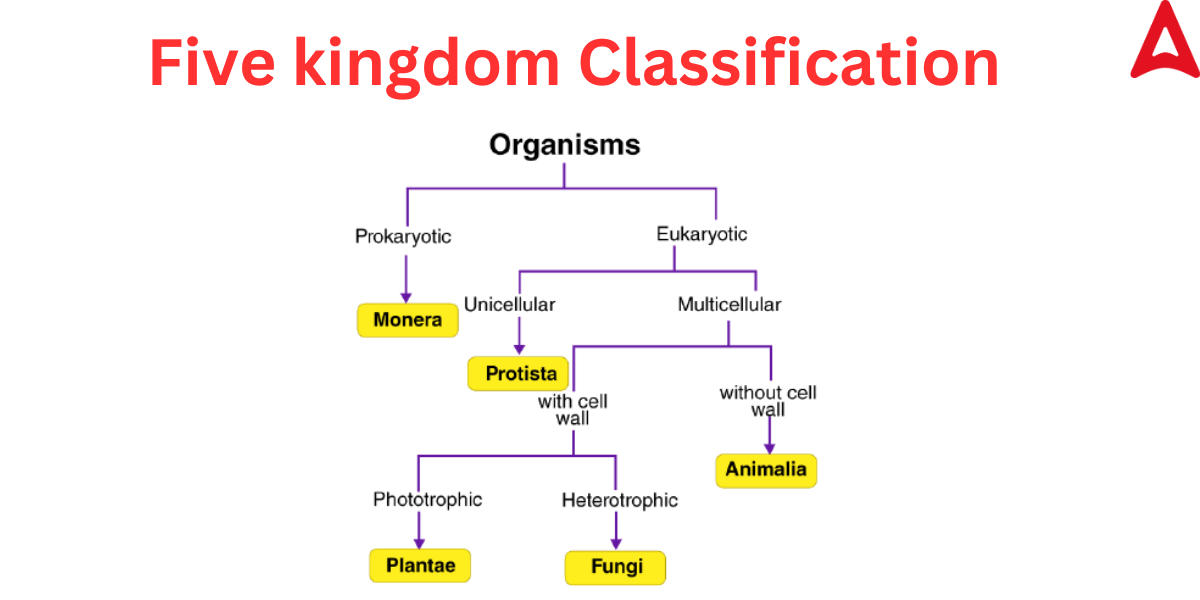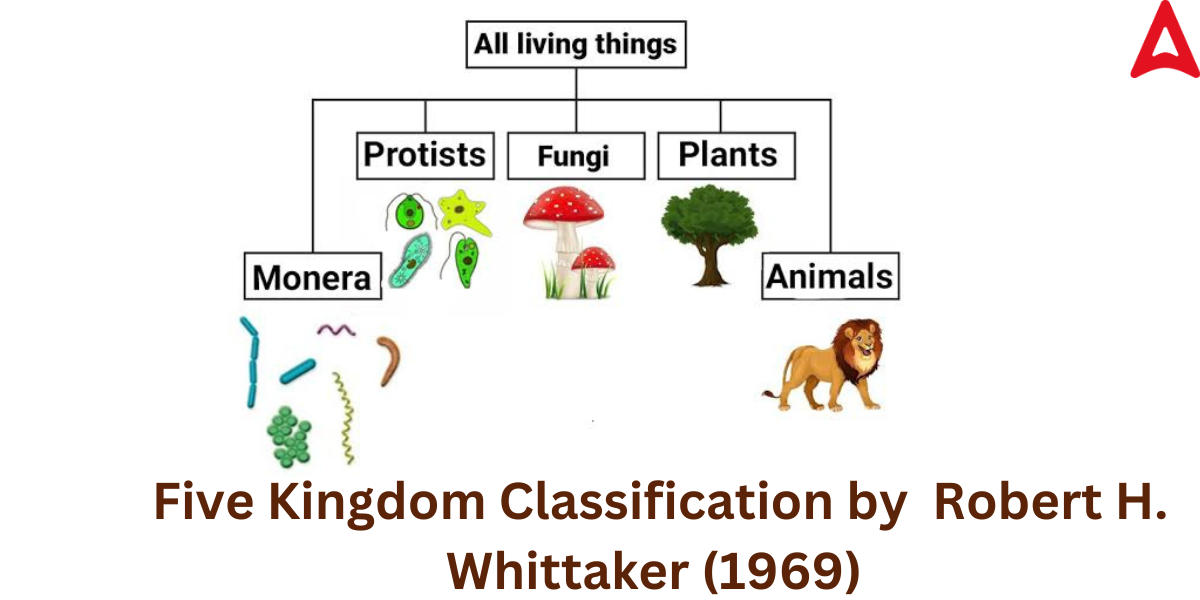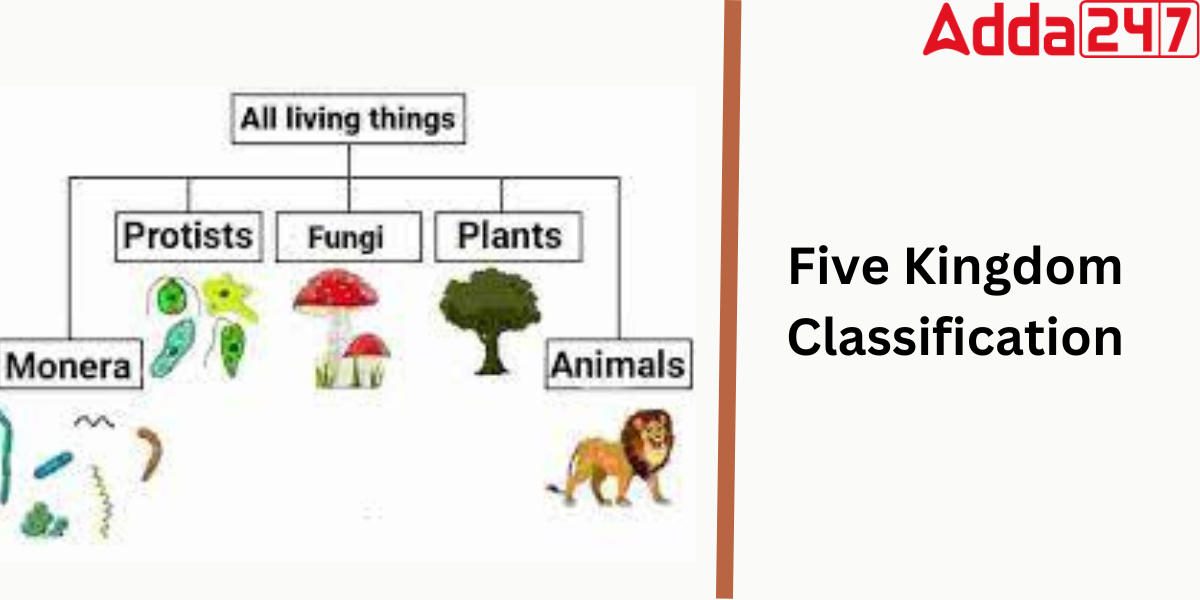Five Kingdom Classification: The five kingdom classification is a very important concept in the study of living Organisms. The Five Kingdom classification was proposed by Robert Whittaker, a biologist in 1969. There are numerous living organisms living on the planet Earth more than 8 million species, and new ones keep being discovered..Numerous scientists have tried to classify these living organisms for centuries. Classification is the process of grouping organisms into groups or sets based on similarities and differences that makes studying a wide range of organisms much easier and more methodical. In this article, we are going to learn about the Five Kingdom Classification in detail along with its characteristics.
Five Kingdom Classification
For decades, scientists have attempted to classify biological organisms, Among these, Robert Whittaker’s Five Kingdom Classification stood out and is frequently used today. The kingdom is the highest level of five kingdom classification, and there are five main kingdoms: Monera (Bacteria and Cyanobacteria), Protista (Unicellular Eukaryotes), Fungi (Fungi and Yeast), Plantae (Plants), and Animalia (Animals). This five kingdom classification is based on characteristics such as mode of nourishment, thallus organization, cell structure, evolutionary relationships, and reproduction. These kingdoms are further subdivided into smaller categories such as phyla, classes, orders, families, genera, and species.
Five Kingdom Classification Chart
Check out the Five Kingdom Classification Flow Chart Below:

Key Facts:
-
The Five Kingdom classification was proposed by Robert Whittaker in 1969.
-
Five kingdoms are included in this Classification: Monera, Protista, Fungi, Plantae, and Animalia(Animals).
-
This five kingdom classification is based on characteristics such as mode of nourishment, thallus organization, cell structure, evolutionary relationships, and reproduction.
5 kingdom Classification
The 5 kingdom classification is the most commonly employed classification scheme of living organisms. In 1969, Robert H. Whittaker proposed a five-kingdom classification. The five-kingdom classification method divides living organisms into five primary groupings based on traits and evolutionary links. The five kingdom classification simplified the classification of creatures into five distinct kingdoms as follows
- Monera
- Protista
- Fungi
- Plantae
- Animalia
Five Kingdom Classification Characteristics and Features
We have discussed the distinguishing characteristics of the five-kingdom classification, which assist us in differentiating and categorizing creatures into five kingdoms based on their crucial characteristics and attributes Let’s Understand some key Characteristics of Each Kingdom included in the five kingdom classification.
Kingdom Monera
Kingdom Monera belongs to the prokaryote Family. Bacteria are classified as part of the Kingdom Monera. These creatures lack a clearly defined nucleus as well as cell organelles.
Characteristics of Kingdom Monera
- Monerans are single-celled creatures.
- They have a prokaryotic cell with no nucleus.
- Monera is devoid of membrane-bound organelles.
- The DNA is unprotected and unbound by a nuclear membrane.
- It is devoid of organelles such as mitochondria, lysosomes, plastids, Golgi bodies, endoplasmic reticulum, centrosomes, and so on.
- Asexual reproduction occurs by binary fission or budding.
- The cell wall is composed of amino acids and polysaccharides and is stiff.
- The flagellum is the locomotory organ.
- Monera is a type of environmental decomposer that is normally quite minute and distributed everywhere.
- Monerans can feed in a variety of ways, including autotrophic, parasitic, heterotrophic, and saprophytic.
Kingdom Protista
Protists are eukaryotic organisms that aren’t plants, animals, or fungi. Protists are unicellular organisms that can also exist as a colony of cells. The majority of protists live in water, damp terrestrial settings, or as parasites.
Characteristics of Kingdom Protists
- Kingdom Protista are generally unicellular organisms, but some are multicellular as well.
- Eukaryotic cells are seen in Protists.
- These organisms often move using cilia, flagella, or amoeboid movement.
- Photosynthesis, intake, and absorption are all ways of nutrition for Protista.
- It is made up of both autotrophs and heterotrophs.
- There is no cell wall in most cases, while certain firms may have one.
- They have organelles, including a nucleus, and chloroplasts, therefore some will be green while others will not. The kingdom is distinguished by the existence of a nuclear membrane.
- Sexual reproduction occurs through cell fusion and zygote creation.
Kingdom Fungi
Kingdom Fungi are multicellular, eukaryotic, heterotrophic creatures. Fungi are non-photosynthetic creatures having chitin cell walls. Some examples of Fungi are mushrooms, moulds and yeast etc
Characteristics of Kingdom Fungi
- Fungi are generally multicellular organisms with some unicellular organisms like yeasts.
- The cells of the organism contain a nuclear membrane.
- Fungi are heterotrophs that can be parasitic or saprophytes.
- This kingdom’s species has a non-cellulosic cell wall composed of chitin and polysaccharides.
- The fungi reproduce through both sexual and asexual means.
- In the kingdom of fungus, there is a lack of mobility.
- Fungi lack chlorophyll and thus cannot photosynthesis.
- Fungi use starch to preserve their food.
Kingdom Plantae
All plants are included in the Kingdom Plantae. Photosynthesis is one of the most important characteristics of this kingdom. They are multicellular, eukaryotic, and autotrophic creatures.
Characteristics of Kingdom Plantae
- Plantae is primarily made up of multicellular creatures.
- Autotrophic nourishment (Photosynthesis) is practiced by organisms in the kingdom Plantae.
- The plant cell has a cellulose-based cell wall that is stiff.
- The plant cell has an outside cell wall as well as a big central vacuole.
- Plantae kingdom creatures are generally stationary.
- They reproduce sexually or asexually by vegetative propagation.
- Plants have photosynthetic pigments called chlorophyll in their plastids.
- Different organelles are present for anchoring, reproduction, support, and photosynthesis.
Kingdom Animalia
This Kingdom contains organisms that are multicellular, eukaryotic, and lack a cell wall. They feed in a heterotrophic manner. They exhibit a wide range of traits and complexities, resulting in a variety of diverse
Characteristics of Kingdom Animalia
- Animalia is primarily made up of multicellular organisms.
- There are numerous phyla and classifications in the Animal Kingdom. Porifera, Coelenterata, Arthropoda, Echinodermata, Chordata, and other phyla are examples.
- Animal cells lack cell walls, or we can say that there is a lack of cell walls in the kingdom. Animalia
- The nutrition mechanism is heterotrophic, which means they rely on other species for nourishment.
- The Animalia kingdom’s organisms Typically show mobility.
- They have a sophisticated organ system. They have muscle cells, which allow them to contract and relax their body parts.
- Reproduction is a sexual process. Asexual reproduction is present in lower forms as well.
Five Kingdom Classification Examples
The Five Kingdom Classification system was a biological classification scheme that grouped living organisms into five major categories based on their characteristics and evolutionary relationships. This classification system has been largely replaced by more modern classification systems, such as the Three-Domain System (Bacteria, Archaea, and Eukarya). However, I can still provide you with examples of organisms that were typically grouped into each of the five kingdoms under the old classification system:
- Animalia (Animals):
- Examples: Humans (Homo sapiens), lions (Panthera leo), dogs (Canis lupus familiaris), butterflies (Order Lepidoptera), and fish (Class Actinopterygii).
- Plantae (Plants):
- Examples: Oak trees (Genus Quercus), roses (Genus Rosa), wheat (Triticum aestivum), ferns (Class Polypodiopsida), and mosses (Phylum Bryophyta).
- Fungi (Fungi):
- Examples: Mushrooms (Order Agaricales), yeasts (Genus Saccharomyces), molds (Genus Penicillium), lichens (Symbiotic organisms involving fungi and algae/cyanobacteria), and rusts (Order Pucciniales).
- Protista (Protists):
- Examples: Amoebas (Phylum Amoebozoa), paramecia (Genus Paramecium), diatoms (Phylum Bacillariophyta), slime molds (Phylum Myxomycota), and algae (Various phyla such as Chlorophyta, Phaeophyta, and Rhodophyta).
- Monera (Bacteria and Archaea):
- Examples: Escherichia coli (a common gut bacterium), Streptococcus pyogenes (causes strep throat), Methanogens (Archaea that produce methane), Thermophiles (Archaea that thrive in extreme heat), and Cyanobacteria (photosynthetic bacteria).
Keep in mind that the Five Kingdom Classification is outdated, and the classification of organisms has evolved based on advancements in molecular biology and genetics. The Three-Domain System, which divides life into Bacteria, Archaea, and Eukarya, is a more accurate representation of evolutionary relationships among organisms.
History of Five Kingdom Classification
Classification is a process that groups or sets of organisms based on similarities and differences. It very systematically simplifies the study of a large range of organisms. The five kingdom classification that we see today was not the initial result of the classification of living beings. Scientists began categorizing biological entities very early on.
Carolus Linnaeus established the first two-kingdom classification, which only included the kingdoms Plantae and Animalia. The two-kingdom classification was maintained for a very long time but did not last forever since many crucial variables were not taken into account when classifying. There were many organisms that could not be classed as either plants or animals, thus simply placing all the organisms in the plant or animal kingdom was insufficient.
All of this uncertainty resulted in a new classification system that had to account for cell structure, the presence of a cell wall, the mode of reproduction, and the source of nourishment. As a result, biologist Robert H. Whittaker suggested the five-kingdom categorization in 1969. He developed this approach to identify and group living things according to their cellular makeup, feeding habits, and other basic traits. The taxonomy area made great strides thanks to Whittaker’s categorization, which offered a more thorough framework for classifying the diversity of life.

Advantages of the Five Kingdom Classification
The five kingdom system of classifying living things took many factors into account and is still the most effective one. The following are some advantages of Robert H. Whittaker’s five-kingdom classification.
- It highlights an important distinction in cellular structure between prokaryotes (Monera) and eukaryotes (the other four kingdoms). It was a sensible choice to classify prokaryotes as a separate kingdom of Monera because they are uniquely organized in terms of their genetic makeup, cellular structure, reproductive system, and physical makeup.
- In the previous classification scheme, two extremely diverse organisms were placed together based solely on that one trait.However, the system identifies a variety of organisms and offers a more thorough taxonomy that takes into account numerous living forms.
- The taxonomy highlights evolutionary ties by classifying species based on core traits and shared ancestry.It has attempted to uncover evolutionary relationships between even the most primitive forms.
Limitations of the Five Kingdom Classification
Apart from the various advantages of five kingdom classifications, This classification system has ceratin limitations these are:
- It is impossible to discriminate between multicellular and unicellular creatures in the case of algae. Because of this, Whittaker did not include single-celled green algae in the Protista kingdom.
- This system does not classify viruses. Archaebacteria have a different structure, chemistry, and physiology than other bacteria.
- Since each group differs so greatly from the others, it is challenging to keep them all together. For instance, the phyla Monera and Protista contain organisms with and without walls, photosynthetic and non-photosynthetic, unicellular, and filamentous or mycelial structures.









 BTEUP Result 2025 Out at bteup.ac.in, Do...
BTEUP Result 2025 Out at bteup.ac.in, Do...
 SGBAU Result 2025 Out, Check Summer Seme...
SGBAU Result 2025 Out, Check Summer Seme...
 How To Prepare for CUET Accountancy Exam...
How To Prepare for CUET Accountancy Exam...









